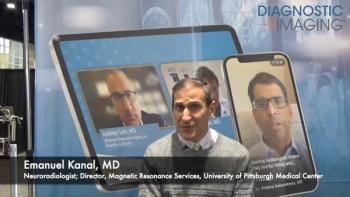
Deep Learning Can Improve the Diagnostic Accuracy of Interstitial Lung Disease
A recent study showed how using artificial intelligence to retrieve reference images could improve diagnosis of interstitial lung disease with chest CT.
Deep learning improved accuracy of diagnosing interstitial lung disease with a proposed content-based image retrieval of similar chest CT images in a recent study.
The retrospective study, published in
Investigators used a proposed content-based image retrieval (CBIR) search engine to pull CT images from a database of these cases, which included usual interstitial pneumonia (UIP), nonspecific interstitial pneumonia (NSIP), cryptogenic organizing pneumonia and chronic hypersensitivity pneumonitis.
Eighty of the cases were used as test cases and the CBIR pulled the top three similar CT images from the database using a deep learning algorithm that compared the extent and distribution of different disease patterns.
Investigators compared the diagnostic accuracy of eight physicians with varying levels of experience before and after the CBIR was applied.
“The proposed content-based image retrieval system for chest CT images by using deep learning can improve the diagnostic accuracy of interstitial lung disease (ILD) and interreader agreement in readers with different levels of experience,” the authors, led by Jooae Choe, MD, PhD, wrote. “This system can be expected to provide radiologic decision support to centers where thoracic imaging expertise is unavailable or cases of ILD are scarce.”
Overall, diagnostic accuracy improved from 46.1% before CBIR to 60.9% after CBIR. Diagnostic accuracy in UIP cases improved from 52.4% to 72.8%, and in NSIP cases from 42.9% to 61.6%.
CBIR also improved the agreement of CT interpretation between physicians (Fleiss k, 0.32 vs 0.47; P = .005).
Among non-radiology physicians, accuracy improved from 52% to 72% in cases with definite UIP CT pattern. For radiology residents, the change was 67% vs 85%.
“A major challenge of CBIR to be used as a decision-supporting tool is finding features and distance measures that match the clinicians’ requirements on the basis of a particular application,” the authors wrote. “By applying deep learning, structural characteristics (eg, reticulation and ground-glass opacity) inherent to a specific ILD pattern can be quantified on CT images with high accuracy and incorporated into CBIR.”
Mark O. Wielputz, MD, professor in the Department of Diagnostic and Interventional Radiology at Heidelberg University Medical Center, wrote in a related commentary that the database should be expanded into a continually growing system and multidisciplinary team discussion is still necessary for final diagnosis.
“Reference image retrieval is appealing because a decision regarding diagnosis is still made by a human reader provided with supporting image information,” Wielputz wrote. “This creates confidence in such systems compared with computational algorithms that provide only a list of differential diagnoses without explanation.”
He described the system as a shortcut in learning the patterns of diseases.
“A pattern-based and automated search should help radiologists and may be a game changer for computer-aided diagnosis,” Wielputz wrote.
Newsletter
Stay at the forefront of radiology with the Diagnostic Imaging newsletter, delivering the latest news, clinical insights, and imaging advancements for today’s radiologists.




























